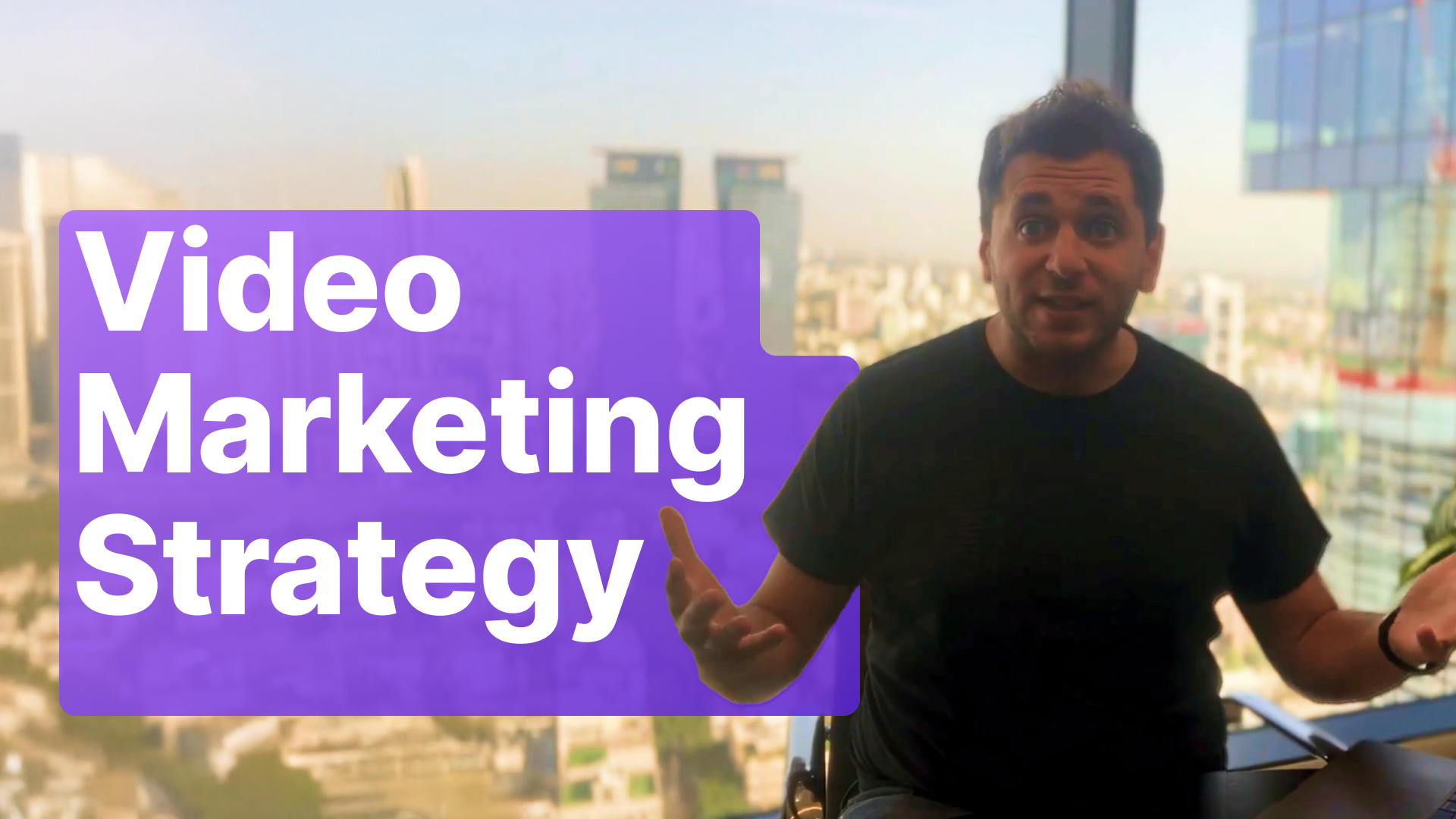
AI Video Marketing Strategy: The Ultimate Guide (2025)
This video marketing strategy will help you to create the perfect flow for editing, scripting, and publishing videos online.

Let's be real: if you're not doing video in 2025, you're basically marketing with one hand tied behind your back.
From bite-sized YouTube Shorts and TikTok Reels to those deep-dive tutorials everyone binges at 2am, video is everywhere. It's how people learn, shop, get entertained, and decide whether they trust your brand enough to hand over their credit card info.
Still posting static images like it's 2015? Using the same tired video tactics from three years ago? Time for a refresh, friend.
This guide will walk you through everything you need to build a video marketing strategy that actually works in 2025 - from planning your first shoot to tracking what's crushing it (and what's flopping).
Why Video Marketing Matters in 2025
Here's the thing: video isn't just "nice to have" anymore. It's the whole damn game.
Attention spans are shorter than ever (thanks, TikTok), competition is fierce, and guess what performs better than literally everything else? Yep, video.
Over 90% of marketers say video has boosted their brand awareness, engagement, and lead generation. Between AI tools making editing stupid-easy, affordable production software, and social algorithms that straight-up prioritize video content, there's never been a better time to jump in.
Why Video Actually Works (Like, Really Works)
1. It Makes People Trust You
People buy from brands they vibe with. A solid video can show your personality, your values, and the humans behind your business in ways that a wall of text just... can't. It's the difference between reading someone's dating profile and actually meeting them for coffee.
2. It Sells Stuff (Big Time)
According to Wyzowl, 82% of people have bought something after watching a brand's video. That's not just engagement - that's cold, hard cash. Show your product in action, demonstrate real value, and watch those conversions roll in.
3. Algorithms Love It (And So Do People)
Social platforms want users glued to their screens, and video does that better than anything else. Result? Your videos get pushed harder, shown to more people, and have a way better shot at going viral than your carefully crafted carousel post.
4. People Actually Remember It
Here's a wild stat: viewers retain 95% of a message when they watch it in a video versus just 10% when reading text. That's not a typo. Your message sticks when it's moving, talking, and engaging multiple senses.
5. The ROI is Insane
Video used to mean hiring a production crew and dropping thousands of dollars. Not anymore. Today's tools mean even scrappy startups can pump out professional-looking content without breaking the bank.
How to Build a Video Strategy That Doesn't Suck
Creating a killer video marketing strategy in 2025 means mixing clear goals, knowing your audience inside-out, telling stories that stick, and letting AI do the heavy lifting. Here's your step-by-step playbook.
1. Figure Out What You Actually Want
Before you hit record, know what you're trying to accomplish. "Get more views" isn't a goal - it's a wish.
Make Your Goals SMART (yeah, we're using that framework, but it works):
- Specific: "Generate 500 qualified leads with a product demo series" not "do better with video"
- Measurable: Track views, watch time, engagement rate, CTR, conversions
- Achievable: Be realistic about your team, tools, and budget
- Relevant: Make sure it ties back to your actual business objectives
- Time-bound: Set a deadline - "by end of Q2" forces action
2. Know Your Audience (Like, Actually Know Them)
Generic content gets generic results. In 2025, people expect videos made for them, not just thrown at them.
How to Stalk Your Audience (Legally):
- Dive into analytics: YouTube Analytics, Meta Business Suite, TikTok Insights - they're goldmines for understanding who's watching and what they want
- Social listening: Tools like Sprout Social show you what topics are trending and what people actually care about
- Read the comments: Seriously. Scroll through your comments, DMs, reviews, and surveys. Your audience literally tells you what they want
3. Mix Up Your Video Types
Don't just make one kind of video. Different formats hit different goals and different stages of the buyer journey.
Short-form videos (15-60 seconds) dominate TikTok, Reels, and YouTube Shorts. Perfect for quick tips, trending content, teasers, or showing what goes on behind the scenes.
Explainer and educational videos help people understand what you do and why it matters. Especially clutch for SaaS, B2B, or anything remotely technical.
Product demos and testimonials build trust by showing real results and real people using your stuff. Nothing beats a customer saying "this actually works."
Livestreams and webinars let you connect in real-time, answer questions on the spot, and build that authentic relationship vibe.
User-generated content makes your audience the star. TikTok challenges, customer testimonials, or even AI-powered UGC that scales while keeping things personal. You can even use AI clones to videos with the same creator with different scripts.
Mix these up and you'll educate, entertain, and convert all at once.
4. Let AI Do the Boring Stuff
AI has completely changed the game for video production. You don't need a Hollywood budget or a film degree anymore - just the right tools.
Top AI Tools That'll Make You Look Like a Pro:
CreatorKit: The game-changer for creating AI Clones from a single image. Build your AI Clone that speaks, moves, and delivers your message in any language - perfect for scaling personalized video content without being on camera. With unlimited video generations and pay-per-download pricing, you only pay for what you use. AI Clone technology means creators can maintain their presence across dozens of videos without recording new footage.
Pictory: Turns your blog posts or scripts into videos with stock footage and AI voiceovers. Great for repurposing content and boosting SEO.
Runway ML: Advanced stuff like background removal, motion tracking, and cinematic effects. For when you want that chef's kiss polish.
Descript: Edit video by editing text (seriously). Plus AI voice cloning and auto-subtitles. Perfect for podcasts and tutorials.
VEED: Offers AI-generated videos from simple text prompts, automated voiceovers, and auto-subtitles. Its features also include background removal, screen recording, and AI-powered translations, making it a versatile solution for marketing campaigns.
Why This Matters:
- Save Time: Automate the tedious stuff - editing, captions, translations - so you can focus on strategy
- Stay Consistent: Keep your brand style locked in across all your videos
- Reach More People: Auto-subtitles and translations mean your content travels further
- Test Everything: Spin up multiple versions fast to see what hits
- Focus on Story: Less time wrestling with software = more time crafting messages that matter
5. Optimize for Where You're Actually Posting
Here's the truth: what works on YouTube bombs on TikTok. Each platform plays by different rules.
YouTube: Aim for 8-10 minutes of valuable content. Nail your SEO with keyword-rich titles, detailed descriptions, and eye-catching thumbnails.
TikTok: Hook them in the first 2 seconds or they're gone. Use trending sounds, add captions, keep it authentic and fun.
Instagram Reels: Visual storytelling is king. Make it pretty, make it lifestyle-y, make it on-brand.
LinkedIn: Keep it professional and educational, under 2 minutes. Your audience is probably watching between meetings.
Facebook: Square format with captions (most people watch with sound off). Simple but effective.
Post consistently and actually engage with comments - the algorithm notices and rewards you.
6. Make Google Fall in Love With Your Videos
Video SEO isn't just nice to have - it's how people actually find your content.
SEO Moves That Work:
- Pack your titles, tags, and descriptions with target keywords
- Add transcripts (helps accessibility AND search rankings)
- Use timestamps in YouTube descriptions so people can jump around
- Embed videos on your website to keep people there longer
- Add schema markup to help search engines understand your content
- Create a video sitemap for better indexing
Pro tip: Do all this stuff and watch your videos climb the search results.
7. Tell Stories That Stick
Good video tells a story. Great video makes people feel something and then take action.
The 3-Part Formula:
Hook (0-5 seconds): Stop the scroll. Hit them with something surprising, bold, or relatable right off the bat. You've got seconds to grab attention.
Value (5-45 seconds): Deliver the goods. Teach them something, solve a problem, make them laugh. Show benefits, not just features. Make it worth their time.
Call-to-Action (Last 10 seconds): Tell them what to do next. Subscribe, share, click, buy - whatever. Make it clear and make it easy.
Storytelling Secrets:
- Emotion beats promotion every time - make them feel something
- Stay authentic - overly scripted content feels fake and people can smell it
- Keep your visual brand consistent (colors, fonts, vibe)
- Add captions and music for accessibility and engagement
- Relatability > perfection - people connect with real, not polished
- Build tension, add surprise, inject humor - keep them watching
- Use classic story arcs: problem → journey → resolution
8. Track What Works, Ditch What Doesn't
If you're not measuring, you're just guessing.
Metrics That Actually Matter:
- View Count: How many eyeballs you got
- Watch Time: How long people actually stick around
- Engagement Rate: Likes, comments, shares, saves - the good stuff
- Click-Through Rate: Are people taking action?
- Conversion Rate: Are they buying, signing up, subscribing?
- Retention Rate: Where are people dropping off?
Make It Better:
- Double down on what's working - if a video's crushing it, make more like it
- Repurpose your winners - turn long videos into Shorts, Reels, or ads
- Update older content - refresh visuals and CTAs to keep them relevant
- Test constantly - try new hooks, formats, styles based on what the data tells you
Your strategy should evolve as your audience and platforms do. Stay flexible, stay curious, keep improving.
The Bottom Line
Video marketing in 2025 isn't optional anymore - it's how you win.
Whether you're creating 15-second TikToks or hour-long YouTube deep dives, video lets you connect with people in ways static content never could. It builds trust, drives sales, and turns casual viewers into loyal customers.
Set clear goals, know your audience, mix up your content types, use AI to work smarter, optimize for each platform, and track everything. Combine creativity with data, experiment like crazy, and stay on top of trends.
The brands crushing it in 2025 aren't just making videos - they're telling stories that matter, building communities, and driving real results.
So stop overthinking it. Grab your phone, fire up that AI tool, and start creating. Your audience is waiting, and every video is a chance to connect with them in a way that sticks.
Now go make something awesome.
